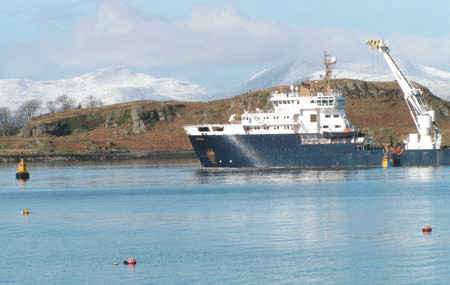| Navigation | |
Harbour navigation
Charles S Dixon
|
|||||||||||||||
Oban demonstrationsDemonstration overview Tests and live demonstrations took place in Oban on the West coast of Scotland, in March 2008. Observers from around Europe saw NLV Pharos undertake a variety of precision manoeuvres in the bay. These included placement of a wreckmarking buoy. Crucial to the success of the demonstration were a number of new systems developed under the MARUSE project, including innovative onboard dynamic positioning technologies and an array of EADS Astrium pseudolites which mimicked Galileo satellite signals. The pseudolites were placed in various locations around Oban Bay, enabling the vessel to use Galileo-like signals for the first time to navigate in British waters. Participants watched the NLV Pharos in real time via closed-circuit television as it manoeuvred. The demonstration was hosted by the Research and Radionavigation Directorate of the General Lighthouse Authorities of the UK and Northern Ireland (GLAs), which include the Northern Lighthouse Board, the Commissioners’ of Irish Lights and Trinity House. Demonstration scenario The public demonstration was based on the concept of action taken to deal with a vessel blocking a busy waterway. It used a combination of HNS pseudolites, GPS and Virtual Aids to Navigation (making use of AIS and Electronic chart displays). The demonstration also used NLV Pharos vessel to undertake the physical demonstrations within Oban Figure 4: NLV Pharos deploying a wreck marker buoy during Oban Demonstration (photo: Dr CS Dixon, EADS Astrium) bay. The scenario for the demonstration is illustrated in Figure 3 and described below: • A simulation of a vessel entering the Oban waterway (using AIS to show its position) is shown on an ECDIS electronic chart display. • (Diagram A) The simulated vessel suffers a failure causing it to remain in the waterway as an obstruction. • (Diagram B) The position of this vessel is marked by the GLAs using the virtual AtoN and its position is broadcast via AIS to all nearby vessels. • (Diagrams C and D) The NLV Pharos is deployed to physically mark the vessel with a Buoy, over the same location as that provided by the Virtual AtoN, using the enhanced positioning from the EADS Astrium Pseudolites. ResultsFor the Demonstrations, code-tracking accuracy was recorded as approximately 2 metres or better. There were measurement and other difficulties; however, subsequent analyses have shown that this accuracy can be reliably achieved. In an operational system, it would be possible to operate using this code-tracking method, or instead to track the carrier signal. Carrier tracking methods have been widely employed in high-precision GNSS applications for some time and yield higher accuracy but lower robustness than code-tracking methods. In separate experiments, EADS Astrium Transmit Station signals have been carrier-tracked with accuracies around 15cm. This was not done for the Oban Demonstrations, but is indicative of what could be achieved if wanted in an operational system. Conclusions and future workA Harbour Navigation System was created by EADS Astrium and was successfully demonstrated with several partner companies as part of GSA Project MARUSE. The demonstrations reported here were undertaken in Oban on the West Coast of Scotland in spring 2008 as part of Project MARUSE. This used Pseudolite Transmission Stations and M&C Station equipment developed by EADS Astrium and described in this article, Receivers from Septentrio, User Terminals from Kongsberg Seatex, and Vessels from the Northern Lighthouse Board.HNA equipment comprising Pseudolite-based Transmit Stations and M&C Station Equipment have been added to the EADS Astrium product range. Future work includes confirming market applicability for various domains and commercialisation of the equipment. Future adaptations of the Equipment for other domains are foreseen. This may include Emergency Management, Rail, Road, and Security-related domains. References[1] Dixon, C.S.: A Maritime Harbour Navigation System based on Pseudolite Transmitters. International Symposium Information on Ships ISIS 2008, September 2008, Hamburg, Germany [2] Dixon, CS and RG Morrison; Demonstration of a Galileo-Based Maritime Navigation System: First Demonstration Results. ENC GNSS 2008 Toulouse, France, April 2008. [3] Dixon, CS and RG Morrison; A Pseudolite-Based Maritime Navigation System: Concept through to Demonstration. Journal of Global Positioning Systems; Volume 7, No.1, 2008. [4] Dixon, CS, M Bolt, A Helliwell, P Lau Semedo, RG Morrison, M Parks, A Whittaker, M Williams; Demonstration of a Galileo Based Maritime Navigation System RIN NAV 07 London, UK, October 2007 [5] Grant, AJ, N Ward, SE Christiansen, CS Dixon, A Suskind; MARUSE Demonstrating the use of Maritime Galileo Pseudolites. ION GNSS 2007 Conference, 25-28 September, 2007. Fort Worth, TX, USA [6] Galileo Open Service Signal-In-Space Interface Control Document. GAL OS ICD/D.0 Issued 2006 Draft 0 AcknowledgementsSome of the work presented here was drawn from other publications, acknowledged above. The author thanks the European GNSS Supervisory Authority (GSA) for their financial support to project MARUSE; it is largely upon the developments from that project that this paper is based. The views and opinions expressed throughout are those of the author, and as such do not necessarily represent those of GSA. Particular thanks are due to Mr. Russell Morrison and the Team at EADS Astrium in Portsmouth who developed and demonstrated the HNS. Support and encouragement from Managements at EADS Astrium is acknowledged. In addition, thanks are due to partners from MARUSE, including Stig Erik Christiansen of Kongsberg Seatex AS, Dr Alan Grant of Trinity House Lighthouse Service, Alain Suskind and Axel Van Den Burg of Septentrio. The author acknowledges generous support of individuals and organisations that helped with, and hosted, pseudolite equipment around Oban. Particular thanks are due to many members of the NLB, to Mrs Aileen Miller, to the very Reverend Donald Mackay and to Argyll & Bute Council. |
|||||||||||||||
|
|||||||||||||||
|
Pages: 1 2














 (No Ratings Yet)
(No Ratings Yet)





Leave your response!